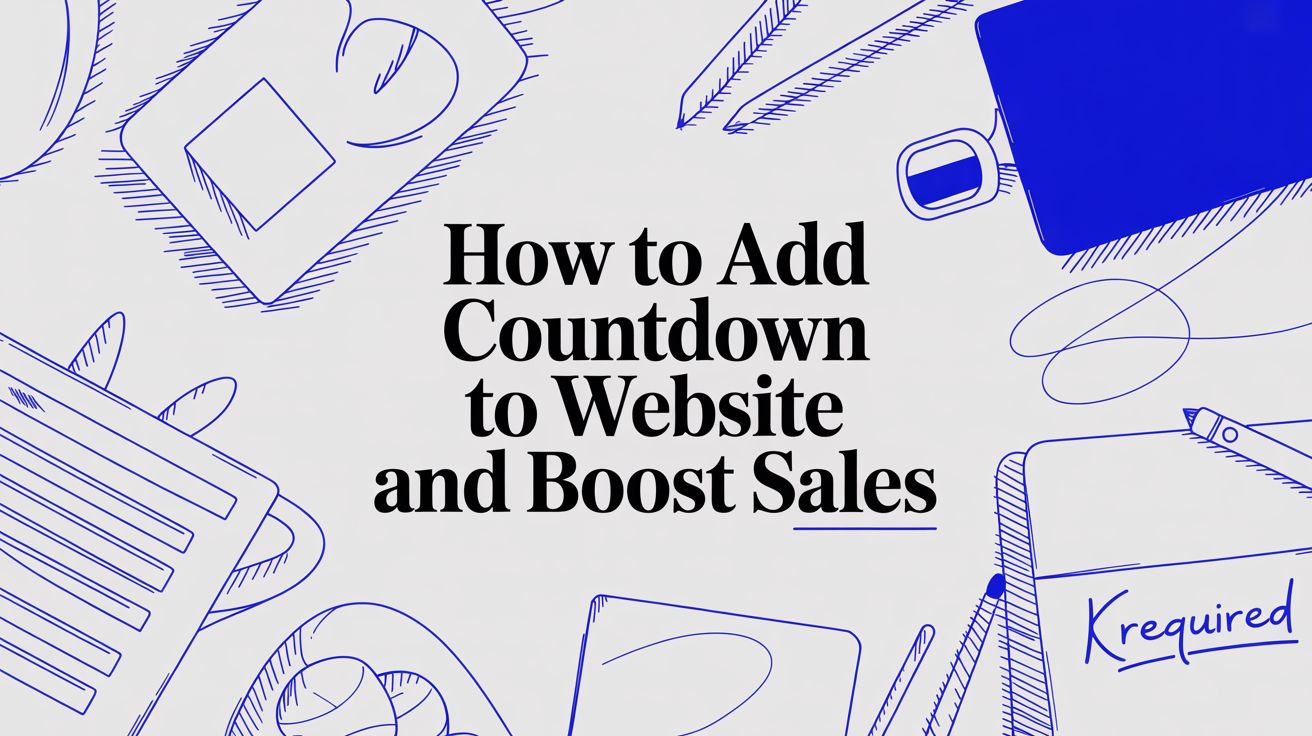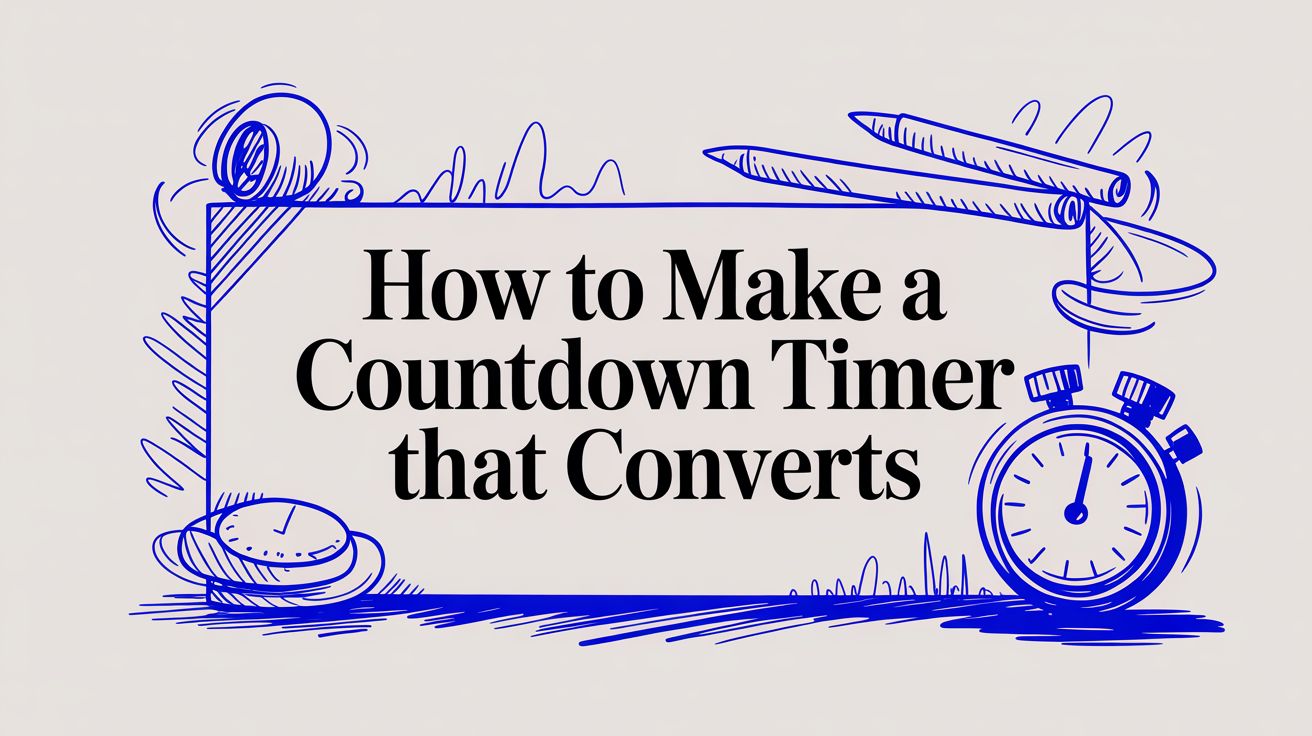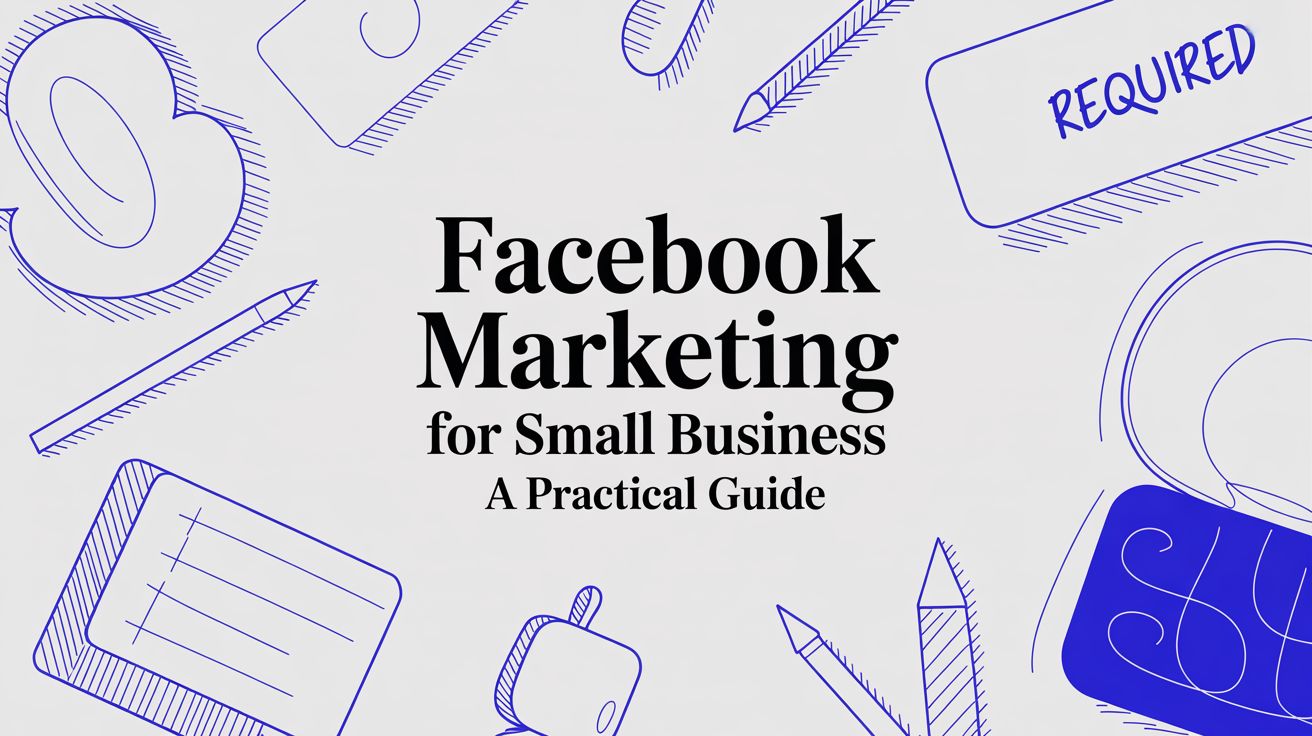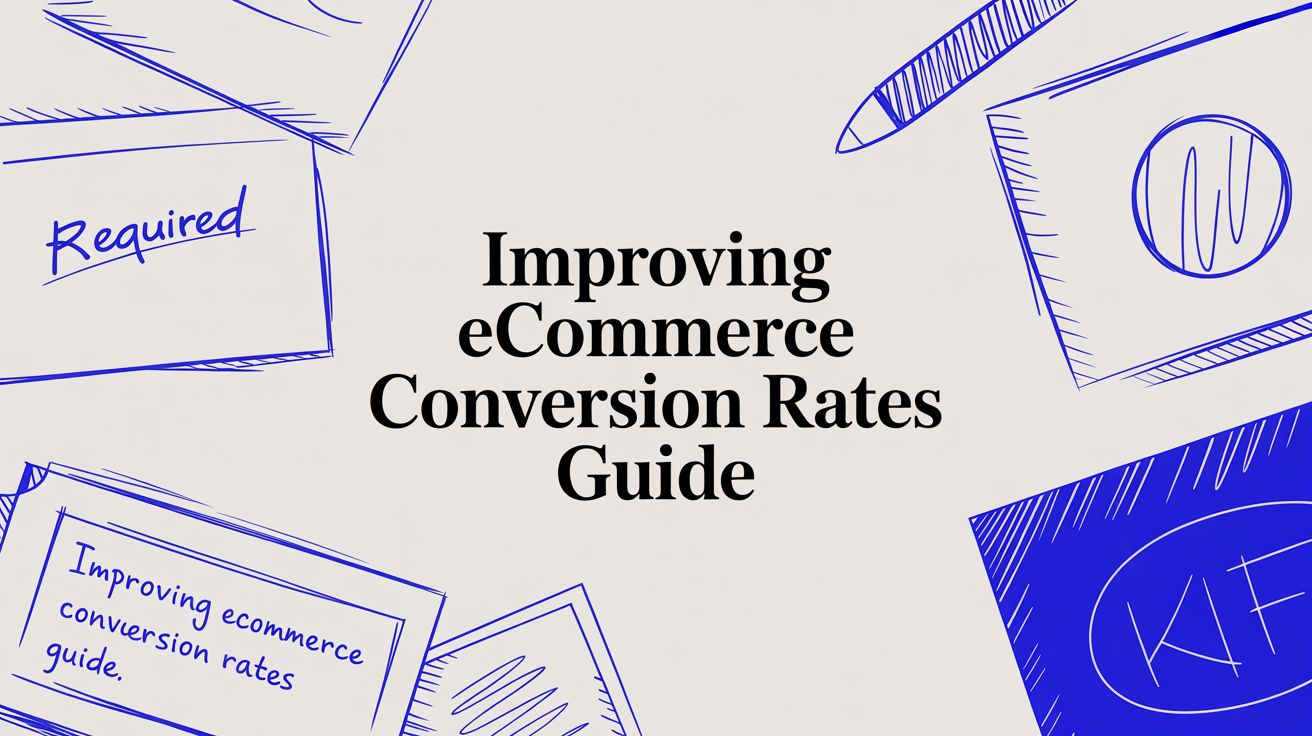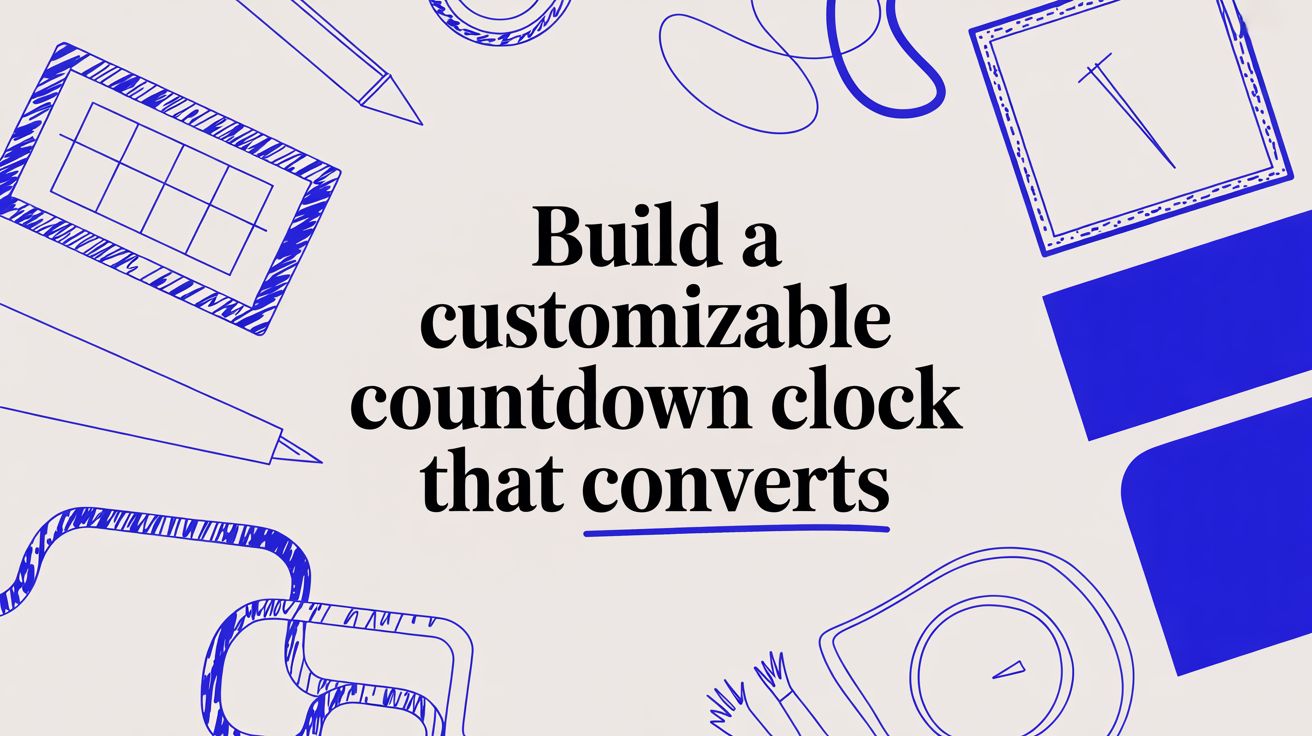How to Create Urgency in Sales and Close Deals Faster
Learn how to create urgency in sales using proven strategies. Discover how scarcity, social proof, and value-driven tactics can help you close deals faster.
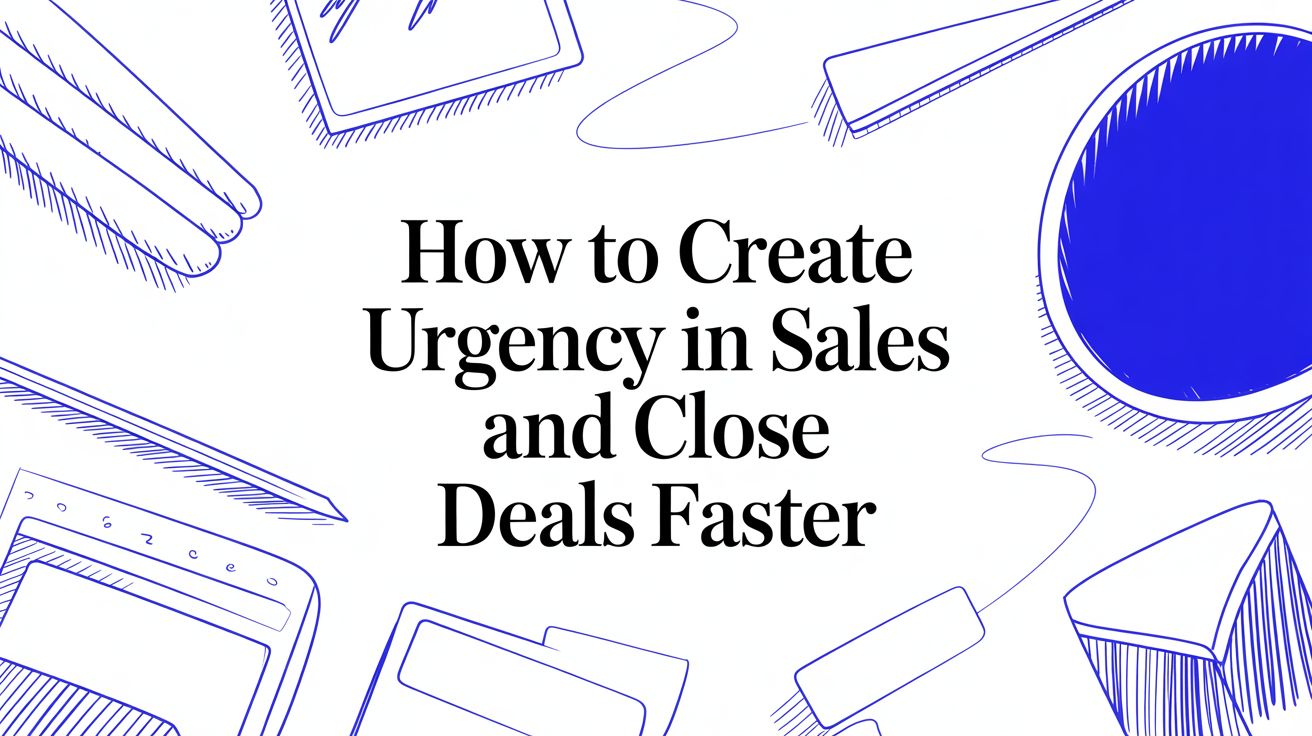
Ever wonder why a "limited time offer" feels so impossible to ignore? It's not just a clever sales trick; it's a powerful nudge rooted deep in human psychology. When we talk about creating urgency in sales, we're really talking about framing a decision so that putting it off feels like a genuine loss. This taps into some pretty strong cognitive biases that quietly guide our choices every day.
The Psychology Behind Sales Urgency
The big one you've probably heard of is FOMO, or the Fear Of Missing Out. It’s that little voice of anxiety whispering that you might miss out on a killer deal, an exclusive item, or a great experience everyone else is getting. When a potential customer sees a banner flashing "Only 3 left in stock," their brain immediately starts calculating the pain of missing the boat.
Key Psychological Triggers
Then there’s loss aversion, which is arguably even more powerful. Researchers have found that the sting of losing something is psychologically about twice as intense as the pleasure of gaining something of equal value.
Think about it. An offer framed as "Don't lose your 20% discount" often hits harder than "Get a 20% discount." Why? Because it triggers our natural instinct to avoid loss. A deadline makes that potential loss feel immediate and very, very real.
These two principles work hand-in-hand to create a powerful incentive to act now:
- Anticipated Regret: It gets customers thinking, "How will I feel if I miss this?"
- Perceived Value: Scarcity—whether it's limited time or limited stock—cranks up an item's perceived worth. If it's not going to be around for long, it must be valuable.
- Decision Paralysis Reduction: A firm deadline cuts through the noise. It simplifies the endless "should I or shouldn't I" debate into a straightforward "yes" or "no" choice.
The goal isn't to manipulate people, but to motivate them. When you can tie your offer to a genuine reason for the deadline—like an upcoming event, a limited production run, or a seasonal promotion—the urgency feels authentic and helpful. It shifts from feeling like pressure to feeling like a legitimate opportunity.
For a deeper dive into these psychological triggers, especially for high-stakes events, it's worth exploring the nuances of creating real urgency. Once you grasp these core concepts, you can build ethical and effective strategies that respect your customers while encouraging them to make a decision.
Driving Demand with Scarcity and Exclusivity
At its heart, creating urgency is all about showing people that the awesome thing you’re offering won’t be around forever. The two best ways to do this are by using scarcity and exclusivity.
These aren't just marketing buzzwords. They're powerful psychological triggers that tap directly into our fear of missing out on a great opportunity.
Scarcity works because our brains are hardwired to value things that are in short supply. Picture an apple tree loaded with fruit versus a tree with just one apple left. That last apple just feels way more valuable, doesn't it?
Harnessing Limited Quantity and Time
You can put this idea into practice in two simple ways: by limiting the quantity of your offer or by limiting the time it's available. Both work like a charm, but they’re suited for different situations.
Limited Quantity is perfect for physical products or services where you can only serve so many people. The classic "Only 2 left in stock!" alert on an e-commerce site is a prime example. It immediately makes you think, "I better grab this now before it's gone." In a B2B setting, you could say something like, "I only have 3 consultation slots left this month." This frames your time as a scarce and valuable resource.
Limited Time, on the other hand, creates a hard deadline for making a decision. Think flash sales, early-bird pricing for a webinar, or a holiday promotion. A ticking clock forces a potential customer to consider your offer now, not "sometime later." This is an incredibly effective tactic for digital products and services where you don't have physical inventory to worry about.
This infographic breaks down how psychological drivers like FOMO, loss aversion, and motivation all play together to influence buying behavior.
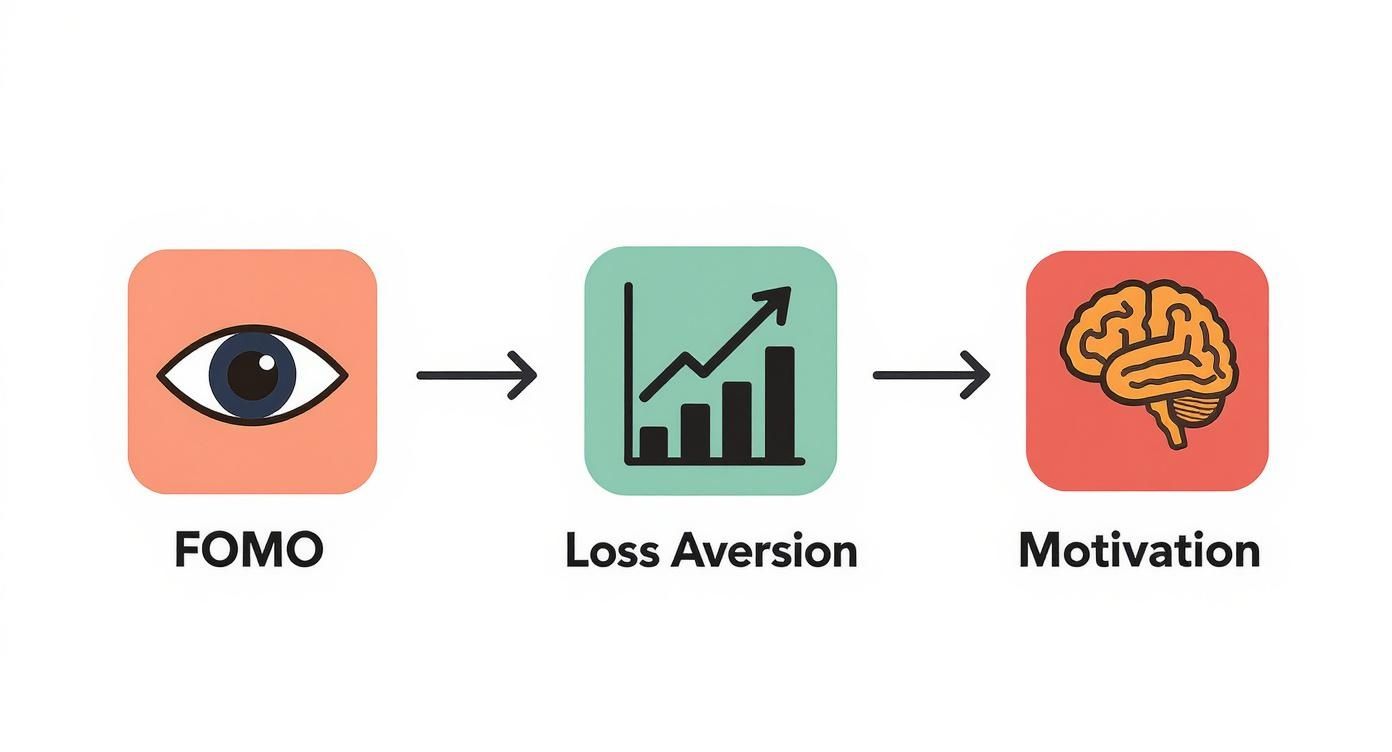
As you can see, the fear of missing out and the desire to avoid a loss are powerful forces that can nudge a customer from "maybe" to "yes."
The Power of Exclusivity
Exclusivity is a close cousin to scarcity, but it's more about making your customers feel special and part of an inner circle. Instead of limiting the product itself, you limit who gets access to a special bonus, a unique version, or a better deal.
For instance, a software company could offer a one-on-one onboarding package exclusively for the first 50 people who sign up. This doesn't just create urgency—it also builds a sense of community and rewards the people who take action first.
Here are a few ways to use it:
- Bonus Offers: "Sign up this week and get our advanced analytics module for free."
- Early Access: "Join our beta program and be the first to try out our new features."
- VIP Tiers: "Our premium members get priority support and exclusive content."
This strategy shifts the conversation from "buy now or it's gone" to "buy now and get something extra that other people won't." It feels less like pressure and more like a unique opportunity.
Comparing Urgency Tactics: Scarcity vs Exclusivity
Deciding between scarcity and exclusivity can be tricky. Both are powerful, but they work in slightly different ways and are better suited for different goals. This table should help you figure out which one fits your situation best.
| Tactic | Psychological Trigger | Best For | Example | | :---------- | :-------------------------------------------------------- | :----------------------------------------------------------------------- | :-------------------------------------------------------- | | Scarcity | Fear of Missing Out (FOMO), Loss Aversion | Physical products, limited-run items, promotions with a hard deadline. | "Only 50 limited-edition prints available." | | Exclusivity | Desire for status, belonging, and special treatment. | Building loyalty, rewarding early adopters, creating VIP communities. | "Join our VIP club for early access to all new collections." |
Ultimately, scarcity creates an immediate need to buy, while exclusivity fosters a longer-term desire to be part of something special. You can even combine them for maximum impact!
One crucial warning: The key to making both scarcity and exclusivity work is authenticity. If you say there are only five spots left, there had better be only five spots left. Your credibility is everything. Fake urgency will backfire and destroy the trust you've worked so hard to build.
Today's buyers have changed the game. By 2025, it's expected that customers will do nearly 70% of their research on their own before they even talk to a salesperson. This means by the time they reach out, they’re well-informed and much more likely to respond to genuine urgency cues.
Building these strategies into your marketing, like using a countdown timer for a big promotion, lines up perfectly with how people make decisions today. To see this in action, check out our guide on killer Black Friday marketing strategies.
Using Countdown Timers for Promotions
If scarcity is the "why," then a countdown timer is the "right now."
Honestly, nothing drives home a deadline quite like a clock ticking down to zero. It’s a direct, punchy way to create real urgency, turning a vague "soon" into a tangible, immediate reason for your customers to act.
A well-placed timer can be a game-changer for product launches, seasonal sales, and early-bird pricing. It’s a constant, visual nudge that an opportunity is about to disappear. Every time a potential customer sees it, they're reminded that time is running out.
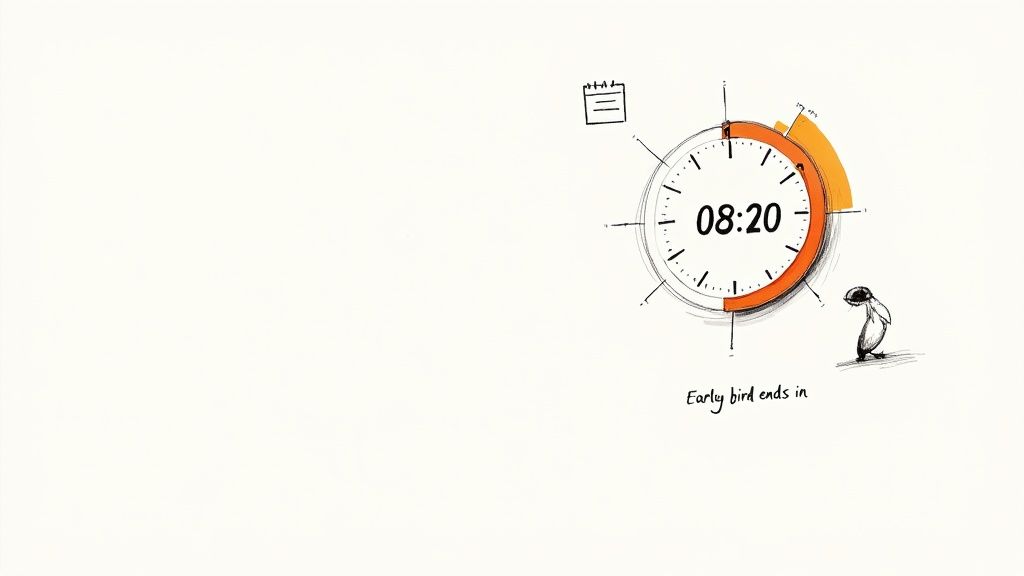
This visual gut punch is so much more compelling than just writing "offer ends soon." The active countdown builds a sense of shared anticipation and a powerful dose of FOMO that’s hard to ignore.
Where to Place Your Timers for Maximum Impact
Visibility is everything. A timer buried at the bottom of a long page might as well not be there. You need to put it right where people will see it, reinforcing the value of your offer at every turn.
Here are some of the most effective spots I've seen work time and time again:
- Website Hero Banners: Stick a timer right at the top of your homepage or a dedicated landing page. It's the first thing visitors see, immediately setting an urgent tone for the entire promotion.
- Product Pages: For e-commerce stores, putting a timer next to the "Add to Cart" button can be the final push a hesitant shopper needs to commit.
- Email Campaigns: Embedding a live, ticking timer directly into your promotional emails can seriously boost click-through rates. When subscribers see the time slipping away right in their inbox, it creates an immediate need to check out the deal.
- Social Media Posts: You can create a countdown graphic that updates automatically in your organic posts on platforms like Facebook. This keeps the urgency front and center for your followers every time they scroll their feed.
The goal is to weave the timer seamlessly into the customer's journey, reminding them of the deadline at every critical moment.
Implementing Timers Without a Developer
Good news: you don't need to be a coding whiz to get a timer up and running.
Plenty of simple tools and plugins are designed for marketers, not developers. Look for solutions with customizable templates that let you match the timer’s colors, fonts, and style to your brand. It should look like it belongs there, not like a clunky afterthought.
Most modern platforms will generate a simple snippet of code you can copy and paste into your website builder or email marketing tool. It’s a set-it-and-forget-it approach that lets you focus on your campaign, not on technical headaches.
A word of caution: The power of a countdown timer lies entirely in its credibility. When the timer hits zero, the offer must end. If customers see your "limited-time" deal is still available hours later, you destroy all trust. Honoring your deadlines is non-negotiable.
What Happens When the Clock Runs Out?
Don't just leave a dead page or a broken link when the promotion ends. That's a huge missed opportunity to engage with people who showed up late to the party.
Instead, think about what you want them to do next.
- Offer an Alternative: Redirect visitors to a similar product or offer a small consolation prize, like a discount code for their next order.
- Capture Leads: This is my favorite. Add a sign-up form so they can be the first to know about the next big sale. You turn their disappointment into a future lead.
- Reinforce the Exclusivity: A simple message like, "Sorry, you missed it!" validates the urgency for everyone who did act in time and teaches latecomers to be quicker next time.
By managing the end of your promotion thoughtfully, you maintain credibility and build a foundation for even more successful campaigns down the road.
Crafting Language That Creates Immediacy
Urgency isn't just about timers and stock levels; it's woven into the very words you choose. The right language can gently nudge a passive browser into an active buyer, while the wrong words can come across as pushy and kill the sale entirely. Your goal is to create immediacy without applying uncomfortable pressure.
Simple, direct phrases are often the most powerful. Think about the impact of statements like:
- "This offer officially ends tonight."
- "This is your last chance to claim your spot."
- "The price increases tomorrow."
These phrases just work. They establish a clear, unavoidable deadline and give people a concrete reason to act now.
Weaving Urgency into Conversations
The real art is slipping this immediacy into your sales calls and follow-up emails so it feels natural. Instead of just dropping a deadline bomb, you can frame it around external factors that give your request for a quick decision some real-world context.
For example, mentioning that a competitor recently inquired about a similar solution can be a gentle nudge. Telling a prospect about an upcoming price change isn't a threat; it's you giving them valuable intel so they can lock in a better deal. These tactics show you’re looking out for their best interest, not just trying to hit your quota.
When urgency is tied to a real event—like a product update, a seasonal promotion, or an internal business timeline—it feels like a helpful tip, not a sales gimmick. This approach builds trust and positions you as a strategic partner.
This shift towards more immediate, personal interaction is changing how sales teams operate across the board.
Modern Tools for Faster Decisions
One of the biggest trends we're seeing is the rise of messenger-based selling. It’s a fantastic way to create urgency because it merges personalization with real-time conversation. Platforms like WhatsApp and Facebook Messenger are becoming powerful sales channels, cutting through the noise with open and click rates often three times higher than email. If you want to dive deeper into this, nethunt.com has some great insights on 2025 sales trends.
These real-time conversations shorten the sales cycle by their very nature. When you can answer a question instantly via chat instead of waiting hours for an email reply, you keep the momentum going and the prospect stays engaged. This direct back-and-forth also helps you understand their needs on the fly.
For tips on making your conversations more dynamic, check out our guide on how to improve Facebook engagement. Ultimately, the key is to make every single interaction feel both valuable and timely.
Combining Urgency with Real Value
Here's the secret to making urgency work without feeling sleazy: it can't stand alone. Urgency without a killer offer is just pressure, and nobody likes being pushed into a sale. When you lean too hard on the deadline without showing people what's in it for them, you're setting them up for buyer's remorse and waving goodbye to their trust.
The best way to light a fire under your prospects is to stack so much value into your offer that the deadline feels like a genuine opportunity, not a trap. The goal is to make them feel smart for acting quickly, not rushed. This flips the script entirely, turning a potentially pushy tactic into a helpful heads-up.
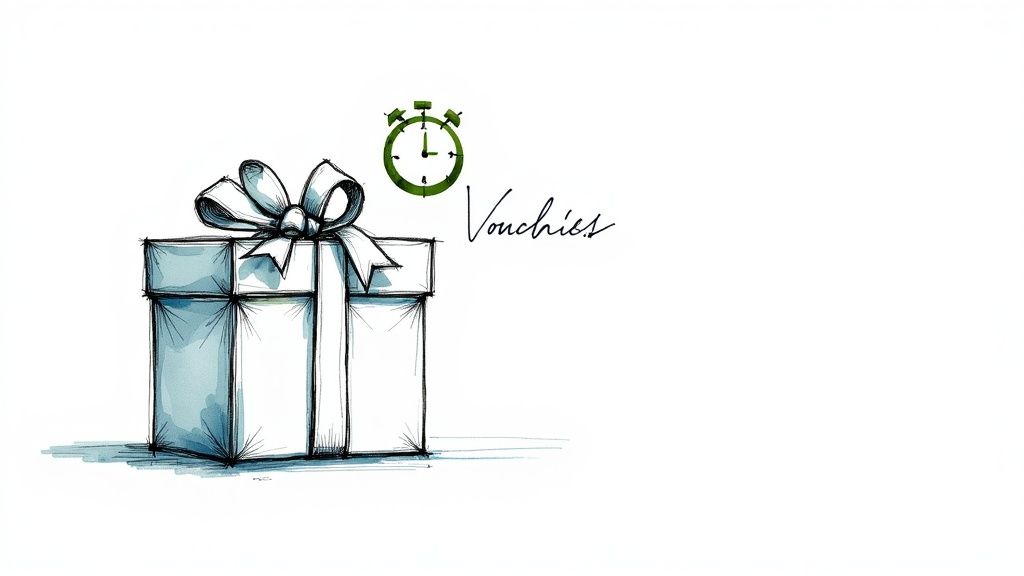
It’s a subtle but powerful shift in perspective. You're not just saying "buy now," you're saying "don't miss out on this extra goodie."
Sweetening the Deal for Fast Movers
Adding a value-packed bonus for people who commit before the clock runs out is a classic for a reason—it works. But this bonus needs to be something genuinely desirable that makes the main purchase even better, not just some random throwaway.
Think about powerful value-adds like these:
- An Exclusive Guide: Offer a downloadable resource they can't get anywhere else, like an advanced strategy guide or a setup checklist. This works great for info products and services.
- Complimentary Shipping: For e-commerce stores, free shipping is often the one thing that tips a customer over the edge. It removes a common pain point and adds real, tangible savings.
- Bonus Features or Services: If you sell software, you could offer a free month of a premium feature. If you're a consultant, maybe you include a complimentary 30-minute follow-up call.
By adding these extras, you’re not just creating a deadline; you're creating a distinctly better version of your offer that only exists for a short time.
The key is to frame the deal as a unique chance to get more for their money. This makes your follow-up emails feel helpful instead of annoying, because you're just reminding them about an exceptional opportunity.
The Power of Persistent Value
This value-first approach also makes your follow-ups feel way more natural. Instead of just pinging prospects with "time is running out!", you’re reminding them of the awesome extras they stand to lose. And that persistence is everything, especially when you look at the numbers.
Creating a little urgency is known to speed up decisions, which is critical since 80% of sales require five or more follow-ups. Here's the kicker: an astounding 92% of sales reps give up after just four attempts. That gap is a massive opportunity where urgency, combined with value-driven communication, can close the deals everyone else abandons. You can read more about these sales follow-up insights on profitoutreach.app.
When your offer is genuinely great, each follow-up is just a friendly reminder of the amazing deal on the table. It makes it so much easier to be persistent without feeling like you're pestering people.
Common Questions About Sales Urgency
Putting these strategies into play always brings up a few real-world questions. I get it. Knowing how to create urgency is one thing, but applying it with confidence when you're talking to a real, live customer is another thing entirely. Let's walk through a few common scenarios you're bound to run into.
How Can I Create Urgency Without Being Pushy?
This is the big one, right? The key is to completely reframe your thinking. Stop focusing on pressure and start focusing on genuine value.
When the urgency is positioned to serve the customer’s best interests, it feels less like a hard sell and more like helpful advice.
Instead of a blunt, "You need to buy this now," you frame it as a benefit they stand to gain (or lose). For example, "We only have 10 spots left in this workshop, and we cap it there to make sure everyone gets personalized attention." See the difference? The reason behind the scarcity is logical and customer-focused. It transforms the dynamic from a threat into an exclusive opportunity.
What Urgency Tactics Work Best for B2B Sales?
In the B2B world, urgency has to make business sense. Forget generic flash sales—they usually fall flat because business purchases are far more calculated and involve multiple stakeholders.
Your best bet is to tie your urgency directly to tangible business outcomes or calendar events. These create logical, unavoidable deadlines that actually resonate with a company's planning and financial cycles.
- Quarterly Pricing Updates: "You can lock in this price before our new rates take effect next quarter." This speaks directly to their budget planning.
- Implementation Schedules: "This is the last implementation slot we have available before the holiday season begins." This is about hitting their operational goals on time.
- Upcoming Feature Releases: "If you sign now, we can get you onboarded in time for our new analytics suite launch next month." This connects the deal to a new benefit they won't want to miss.
This approach grounds the urgency in the real-world context of their business, making it a strategic consideration, not just a sales tactic.
The most effective B2B urgency is rooted in the customer's own timeline. If they tell you they need to roll out a solution in three months, your job is to help them understand why signing the contract now is the only way to hit that goal. You're mapping your deal directly to their success.
What if a Customer Misses a Deadline?
Tempting as it is to make an exception, holding firm to your deadlines is non-negotiable for your long-term credibility.
If you constantly extend offers, your customers will quickly learn that your deadlines are meaningless. This completely torpedoes any future attempts to create real urgency. They'll just assume they can wait you out.
However, you don't have to be a robot about it. When a customer genuinely misses out, you can soften the blow while still protecting the integrity of your promotion. Offer a reasonable alternative, like free shipping instead of the 20% discount they missed, or an invitation to an exclusive waitlist for the next promotion. This shows goodwill without devaluing your original offer.
Ready to build anticipation and drive action on your social media? With Countdown Timer App, you can create and publish stunning, auto-updating countdowns directly to your Facebook page or website. It's perfect for launches, events, and limited-time offers. Get started for free at https://www.countdown-timer.app.

